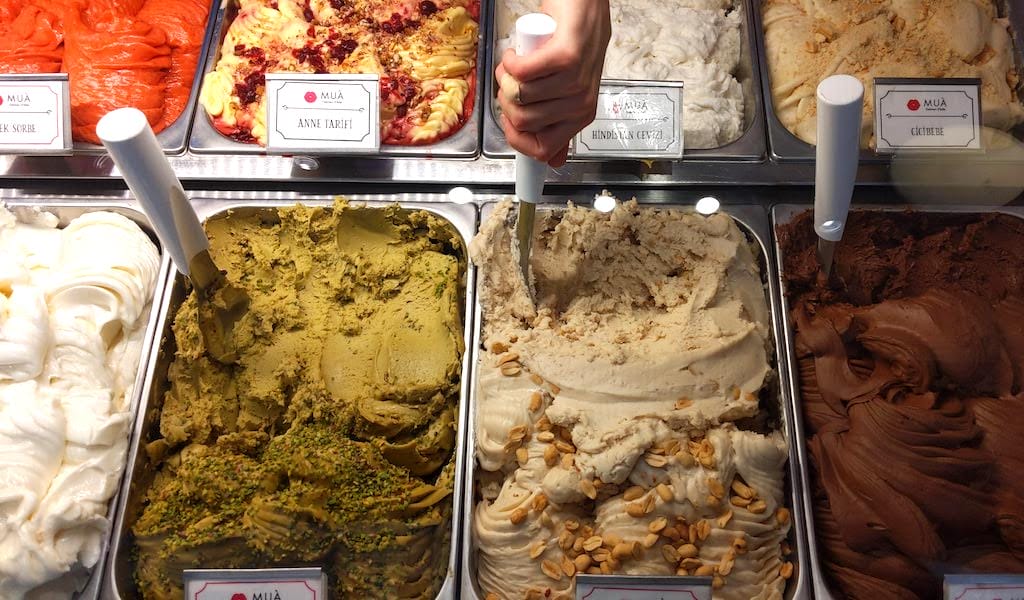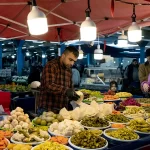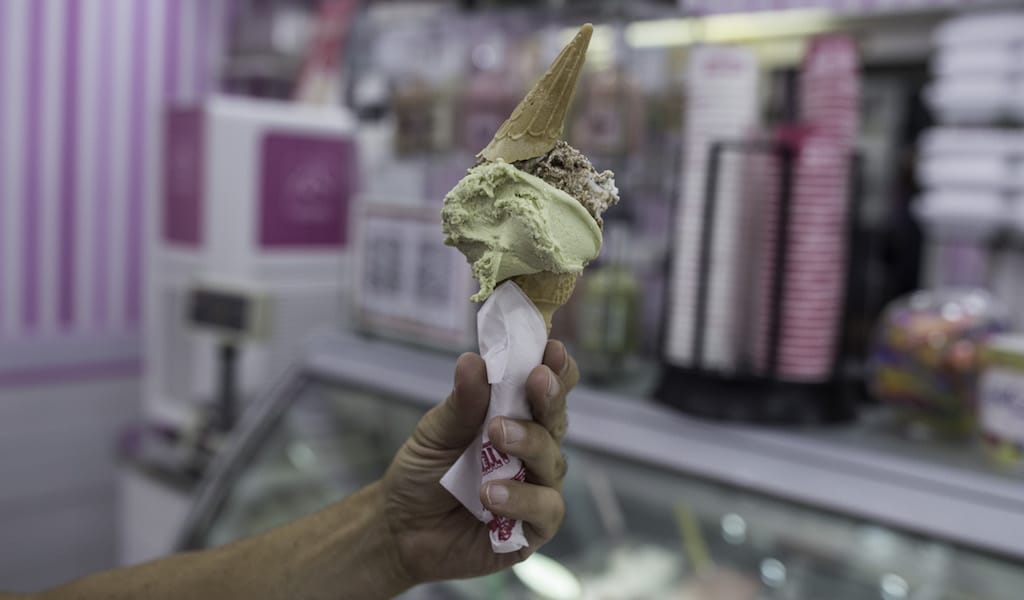In these days of viral Instagram videos and WhatsApp chainmail, Turkish ice cream has become synonymous with fez-clad pranksters swooping and slinging a mound of sticky Kahramanmaraş dondurma (ice cream) out of the hands of questionably amused tourists.
But Turkey’s dondurma tradition goes far beyond these attention-seeking tricks. Beloved institutions offering more than simple (though delicious) chocolate or pistachio – like Kadıköy’s Dondurmacı Ali Usta, the countless Mado operations, Dondurmacı Yaşar Usta and Bebek’s Mini Dondurma – will never lose their loyal customer base. With such a wealth of frozen creams, it’s no surprise that gelato only arrived on the scene in Turkey in the mid-2000s, when the first Cremeria Milano opened its doors at the Tünel terminus of Istiklal Avenue (it now has some 18 locations throughout the country).
Our CB Barcelona chief, Paula Mourenza, wrote about how Barcelona’s largest community of immigrants – the Italians – introduced gelato into the culture of ice cream in the Catalan city. Amedeo Colella, our CB Naples chief, had no trouble expounding on a Neapolitan gelateria that has been in business since the 30s. So what does Istanbul – whose gelato industry has grown exponentially in the form of listless mall franchises over small-batch artisanal shops – have to contribute to this centuries-old dairy art form? We say: Baklava, fig and honeydew.
Here are two Istanbul gelaterias adding a Turkish twist to classic Italian techniques, creating new and delectable dondurma from traditional tastes.
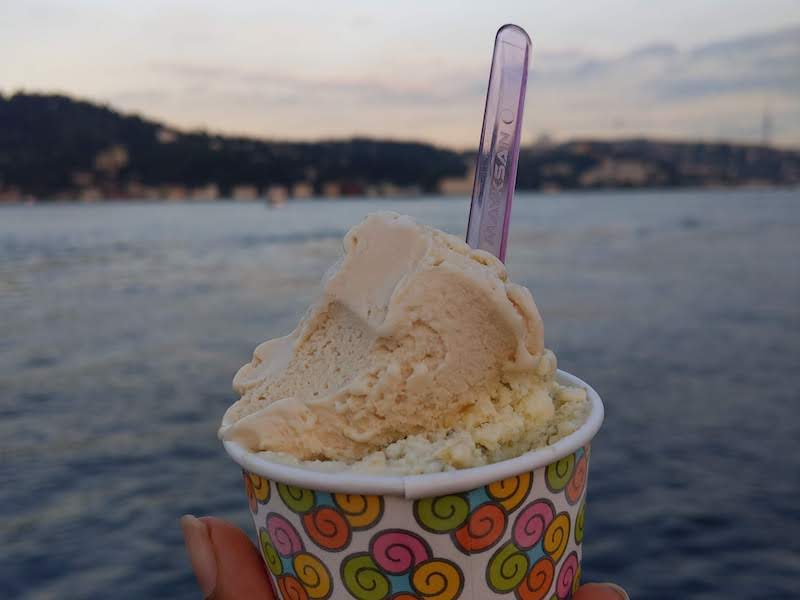
Girandola Dondurma
On balmy summer nights in 2013, we remember walking for hours along the European banks of the Bosphorus Strait. A late-night snack of fried mantı at the now-shuttered Arnavutköy Bodrum Mantı would be capped with a stop at Girandola Dondurma. We’d snag their almost-always creative flavor of the day, and we’d set off again, cone in hand, to finish our stroll under the stars. Seven years later and there’s still no doubt, Girandola beats any other local gelateria with the sheer magic of its location on the Bosphorus’ sparkling waters.
First opened in 2008 by Aslıhan Eraltan and her husband Ufuk, Girandola’s creamy quality and unique, local flavors have made it an ice cream institution in its own right. Here, you can find gelato classics like tiramisu and stracciatella – but there’s nowhere else in the world Italian gelato will combine so elegantly with Turkish delights, giving you flavors like kazandibi, güllaç or baklava.
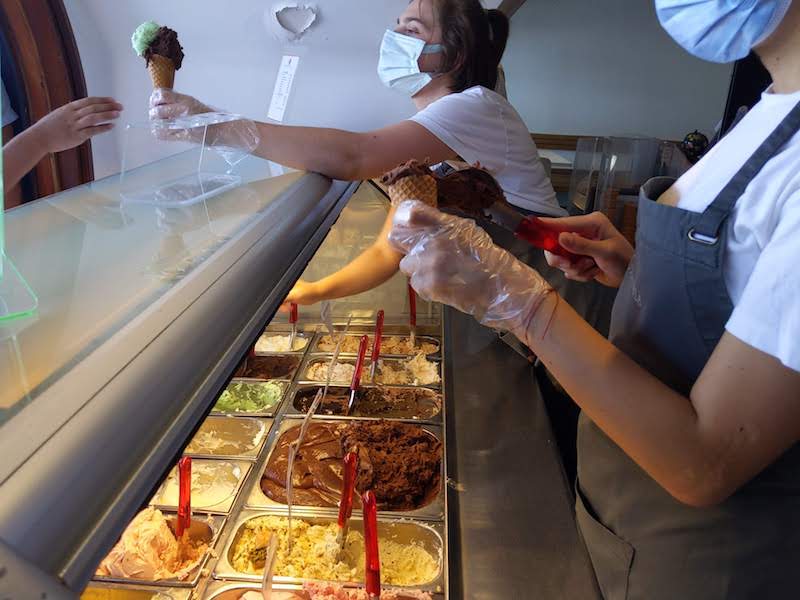
Aslı fell in love with gelato while studying in Italy in 1993. “In Turkey, there was no gelato,” she says. “And Turkish ice cream didn’t have the variety of flavors I wanted.” After working as a tour guide for French, Portuguese and Italian tourists in Turkey, she thought, “If I could just have a shop, people would come. They’ll like it. They’ll hang out. It wasn’t a big plan or project – it’s just, I loved gelato. And I was tired of tour guiding.” Always an experimenter in the kitchen, Aslı enrolled herself at an Italian university in 2006 to learn gelato-making from a master. She made her first batch with equipment she purchased in Italy on her husband’s birthday a year later. Then, “it just happened,” she says. While walking around her neighborhood, she found the perfect location for her gelateria, and it was for sale. “Everyone helped me. A friend designed my logo, another worked on the store. My husband did the finances. And cone by cone, we starting doing well.”
“In Turkey, we have good ice cream,” Aslı says. “But it uses salep [orchid flour starch], more fat and more sugar. I prefer the softness of gelato – which is frozen at a higher temperature – as do many others here, we learned. But if you use the right milk, right sugar and the right seasonal fruits, whatever you make will be great. This is true for everything, not just gelato.”
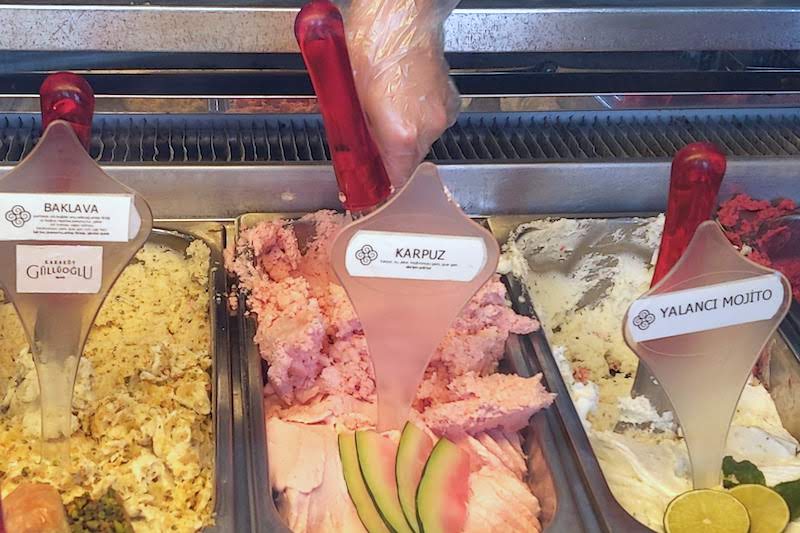
With Cremeria Milano in Beyoğlu being the only other gelato shop in town, Girandola quickly became a worthy contender. Aslı says she is constantly working on new flavors. Some of our favorites include those taking inspiration from what’s around. Kazandibi, the flavor of the day on Thursdays, is a Turkish pudding made of chicken breast (yes, you read that right). “This flavor was a total accident,” Aslı says. “I cooked a batch a little too long and it formed a burnt crust that tasted just like the browned layer of kazandibi!” The Ramadan dessert known as güllaç, a milk-soaked pastry with rose and pistachio served only during the holy month, is even better in Girandola’s gelato form. During the 2013 Gezi Park protests, a biber gazı (pepper spray) flavor, which incorporated red peppers, also made a brief stint on the menu.
The addictive baklava flavor is a new addition, the result of an Instagram poll on the Girandola account. Aslı took the poll seriously, though, and invited Murat Güllü of the famous Karaköy Güllüoğlu (our go-to baklava in Istanbul) to her workshop to collaborate. Together, they created Girandola’s baklava ice cream, which is also sold on-site at Karaköy Güllüoğlu. Each bite is full of flaky, buttery phyllo encrusted with pistachio. Aslı says she loves being pushed to create new flavors, her most unusual being beyaz peynir (a feta-like white cheese) for the menu at the rooftop 360 Istanbul restaurant. She says of her process: “Ufuk and I eat something, and we think, ‘Wouldn’t this make a great gelato?’”
Girandola is Turkey’s second home-grown gelateria, and has proven to be as much of a success as its first – with more unique flavors and local partnerships. Girandola has opened eight other branches across Istanbul, and continues to make all of its gelatos daily.
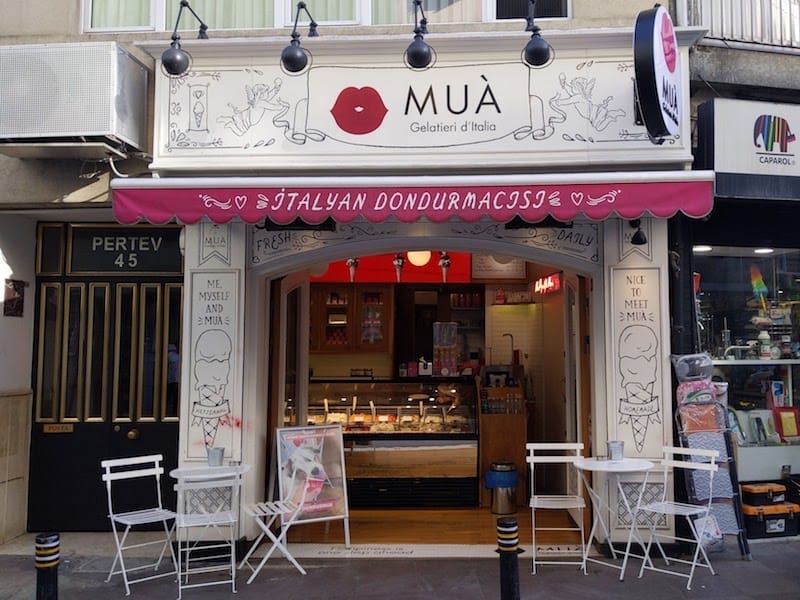
MUÀ
While studying business and economics at university, getting into cooking became a hobby that twins Burç and Burak Yener started taking more and more seriously. “We realized we had to go to Italy to learn how to make chocolate, pastry and gelato,” So, as one does, they moved to Bologna.
“We met many maestros and visited a ton of gelato shops up there,” Burç tells us. “We also worked at our own maestro’s gelato shop in the Rimini area.” For two years, they ran the clock on their visas, going back and forth to Italy to gain the experience and knowledge necessary to open their own shop in Istanbul. In 2017, at the age of 24, they opened Mua to wild success.
If you use the right milk, right sugar and the right seasonal fruits, whatever you make will be great. This is true for everything, not just gelato.
For the twins, ice cream culture runs deep in Turkish cuisine. “But it’s not gelato – it’s maraş,” Burç says, speaking of the classic dondurma made sticky with salep and sweetened with mastic. Echoing Aslı, Burç says that in Italy, gelato is soft, compared to Turkey where the dondurma is “rock hard.” He believes that “gelato is the best form of ice cream. It has more flavor. It’s healthier. But what we realized is that, if you want to do gelato in a country like this, you have to adopt.” Culture to culture, he says, everything changes. At Mua, the gelato is colder than the Italian version, less soft. But, he insists: “The principles are the same. We are doing small batch, on-site production at every shop – we now have eight.”
The twins are particularly proud of that fact. “On-site production is way better,” Burç explains. “With this style, we can have more fresh and daily products.” He tells us that producing gelato at one location for distribution means having to figure out storage and additives for preservation, which lowers the quality. “We decided to keep things on-site to keep the texture, quality and taste fresh. We have strict policies when it comes to our recipes.”
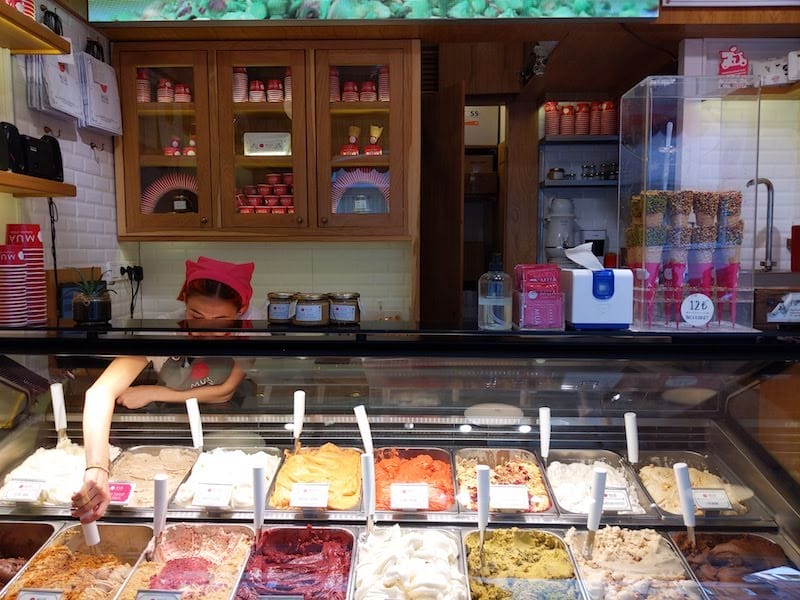
Mua’s dondurma is less sugary than typical gelato as well, striking the right balance of savory and sweet, especially in their nut-based ice creams. They also have a large selection of rich dairy-free sorbets, and all of their offerings are gluten free. “We think it’s healthier, and we want to help out our vegan customers who don’t get a lot of attention here,” Burç says. Our favorite is without a doubt the peanut butter, which has a slight salty kick. Both honeydew and apricot, when they are in season, are refreshing choices. Mua buys its local fruits and nuts directly from farmers, “both to support them and to get the highest-quality products,” Burç says.
For the twins, more important than staying true to Italian techniques is bringing people joy through gelato. “That’s what ice cream is about,” Burç says. “Sure, we believe that we are creating the tastiest gelato, but taste changes from person to person. The best comparison is in the vision and mission of the business,” he says. “Considering nature, respecting customers and workers at the shop – these are more important than an ice cream flavor.” He tells us that the pandemic has been a huge strain on the business: “But we are continuing because we want to spread happiness to the people who need it. We are not selling ice cream, we are selling joy.”
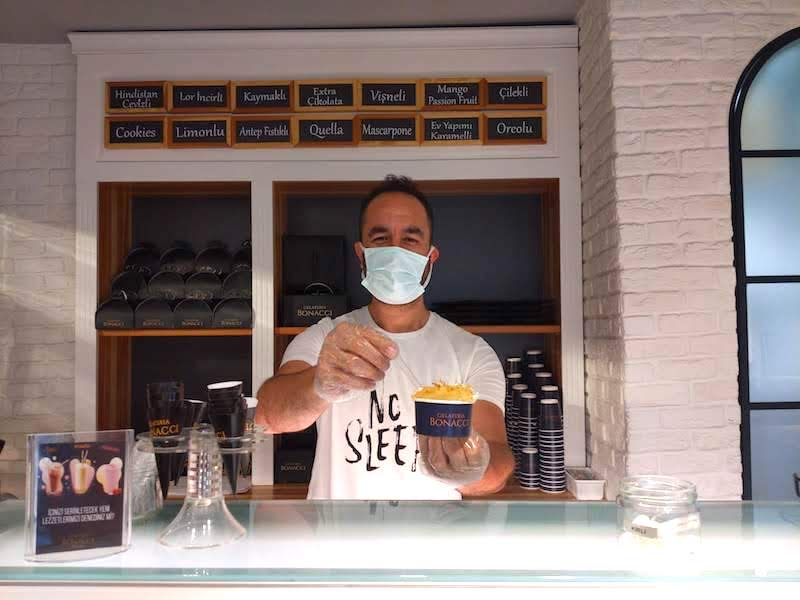
—
Honorable mention:
Gelateria Bonacci Bomonti
The Bomonti location of Gelateria Bonacci may not be the flagship, but its owner Metin Ergün and pastry chef Tolga Akpınar negotiated creative license into their franchise contract. A handful of their daily flavors are sent in from the main shop, but 90% are made in-house by Tolga each morning – often with local products (like a recent option of walnut) from the enormous Feriköy farmers’ market just around the corner. Open late (an unspoken requirement of ice cream shops the world over), we sauntered into Bonacci around 11p.m. to exclaim over two of Tolga’s creative takes: kadayif (shredded phyllo) and green fig. The kadayif adds a superior crunch that balances the gelato’s sweet notes of kaymak (clotted cream). The fig is a sorbet like no other – at once tart and treacly, it’s loaded with fresh fruit, seeds spotted throughout.
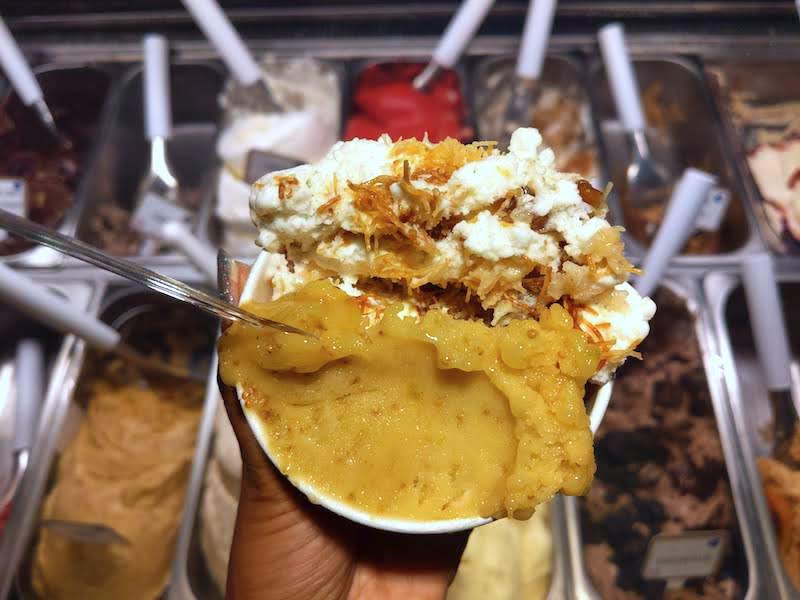
The pastry chef, who was trained in Italy, only churns his original creations for Bonacci Bomonti, Metin proudly tells us. “Every neighborhood is different with different tastes,” he says. “Flavors like raspberry can do well here, but not so much at the other Bonacci locations. So we asked for the privilege to make our own flavors. We only use fruits and milks. If you don’t do anything else, it’s going to be good.” He’s right. It is.
Published on August 27, 2021
Related stories
March 30, 2022
IstanbulQuick bite: Far from the tourist trail, get a taste of one of the last bastions of classic Istanbul flavors, including bread fresh from the tandir oven, a mind-boggling assortment of meze, sizzling kebab, old school ice cream and much more. On this full-day food tour, we will dig deep into the culinary traditions of…
February 18, 2016
IstanbulQuick bite: Istanbul’s Bazaar Quarter is one of the world’s biggest open-air commercial centers and a historic hub of small craftsmen who still carry on their tradition in the atmospheric caravanserais. On this 6-hour Grand Bazaar food tour, we will meet and eat with these craftsmen. Istanbul’s Bazaar Quarter is one of the world’s biggest open-air…
August 25, 2021
NaplesNaples’ Forcella district is known throughout Italy for the starring role it plays in the drama that is the city’s underworld; many Camorra (Neapolitan mafia) members call the neighborhood home. Today, this district is experiencing a moment of redemption both artistic and cultural. The former can be seen in the murals and old, repurposed cinema…







































